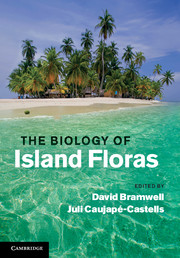Book contents
- Frontmatter
- Contents
- Contributors
- Preface
- 1 Introduction: islands and plants
- 2 The reproductive biology of island plants
- 3 Spatial methodologies in historical biogeography of islands
- 4 Origin and evolution of Hawaiian endemics: new patterns revealed by molecular phylogenetic studies
- 5 Origins and evolution of Galapagos endemic vascular plants
- 6 The plants of the Caribbean islands: a review of the biogeography, diversity and conservation of a storm-battered biodiversity hotspot
- 7 The biogeography of Madagascar palms
- 8 Evolution and biogeography of the flora of the Socotra archipelago (Yemen)
- 9 Biogeography and conservation of the flora of New Caledonia
- 10 Phytogeography and relationships of the Pitcairn Islands flora
- 11 Chromosomes and evolution in New Zealand endemic angiosperms and gymnosperms
- 12 Jesters, red queens, boomerangs and surfers: a molecular outlook on the diversity of the Canarian endemic flora
- 13 Endemism and evolution in Macaronesian and Mediterranean Limonium taxa
- 14 Dispersal, diversity and evolution of the Macaronesian cryptogamic floras
- 15 Invasive alien species and islands
- 16 Ecology, demography and conservation in the Galapagos Islands flora
- 17 New directions and challenges for the conservation of the flora of Madagascar
- 18 Climate change and island floras
- 19 Conservation status of endemic plants on Isla del Coco, Costa Rica: applying IUCN Red List criteria on a small island
- 20 Botanic gardens and the conservation of island floras
- 21 The hazardous future of island floras
- Index
- References
9 - Biogeography and conservation of the flora of New Caledonia
Published online by Cambridge University Press: 07 October 2011
- Frontmatter
- Contents
- Contributors
- Preface
- 1 Introduction: islands and plants
- 2 The reproductive biology of island plants
- 3 Spatial methodologies in historical biogeography of islands
- 4 Origin and evolution of Hawaiian endemics: new patterns revealed by molecular phylogenetic studies
- 5 Origins and evolution of Galapagos endemic vascular plants
- 6 The plants of the Caribbean islands: a review of the biogeography, diversity and conservation of a storm-battered biodiversity hotspot
- 7 The biogeography of Madagascar palms
- 8 Evolution and biogeography of the flora of the Socotra archipelago (Yemen)
- 9 Biogeography and conservation of the flora of New Caledonia
- 10 Phytogeography and relationships of the Pitcairn Islands flora
- 11 Chromosomes and evolution in New Zealand endemic angiosperms and gymnosperms
- 12 Jesters, red queens, boomerangs and surfers: a molecular outlook on the diversity of the Canarian endemic flora
- 13 Endemism and evolution in Macaronesian and Mediterranean Limonium taxa
- 14 Dispersal, diversity and evolution of the Macaronesian cryptogamic floras
- 15 Invasive alien species and islands
- 16 Ecology, demography and conservation in the Galapagos Islands flora
- 17 New directions and challenges for the conservation of the flora of Madagascar
- 18 Climate change and island floras
- 19 Conservation status of endemic plants on Isla del Coco, Costa Rica: applying IUCN Red List criteria on a small island
- 20 Botanic gardens and the conservation of island floras
- 21 The hazardous future of island floras
- Index
- References
Summary
Geography
Straddling the Tropic of Capricorn, New Caledonia is situated in the South Pacific Ocean between latitudes 18° 00′ and 23° 50′ S, and longitudes 154° 45′ and 176° 20′ E. It is an archipelago made up of the islands of Grande Terre, Iles Belep, d’Entrecasteaux Récifs, Île des Pins, the Loyalty Islands and several other small islands such as the Chesterfield Islands and Walpole Island (Fig. 9.1). New Caledonia is an isolated archipelago situated some 1500 km east of Australia with the nearest land further to the east at the New Hebrides Islands and Fiji. New Caledonia is one of the extant land masses of an ancient continent known as Zealandia and now almost completely submerged. The island was formerly part of Australasia but separated from it about 60–80 million years ago (Ma) and drifted to its present position by about 50 Ma. It is, therefore, one of the most important and isolated surviving fragments of Gondwanaland. In the process, much or all of the area of New Caledonia appears to have been submerged for up to 20 Ma. During this period, oceanic mantle was deposited over the original schistic rock, eventually forming a thick layer of ultrabasic substrates including peridotite, ferricrete, serpentinite and laterite. These were once widespread over the islands and still cover about 30% of the land surface.
- Type
- Chapter
- Information
- The Biology of Island Floras , pp. 226 - 238Publisher: Cambridge University PressPrint publication year: 2011
References
- 1
- Cited by



